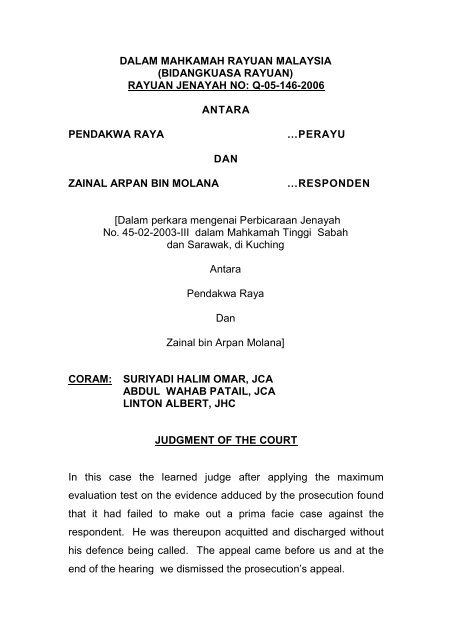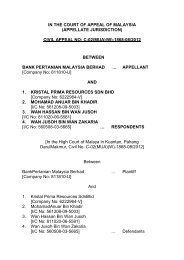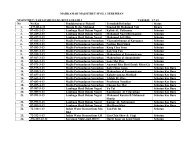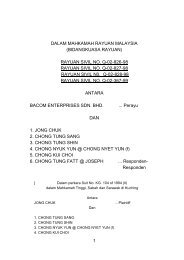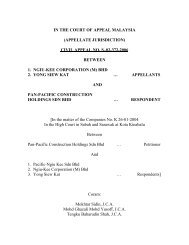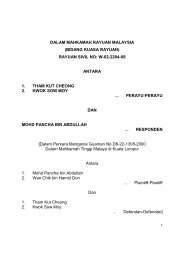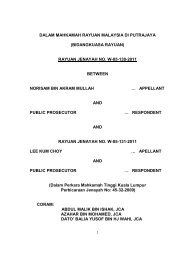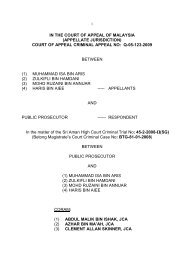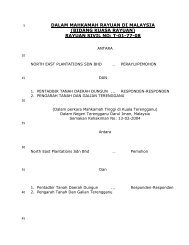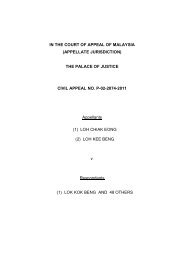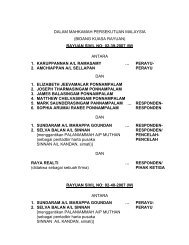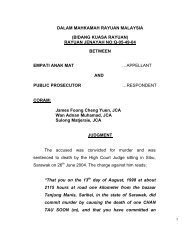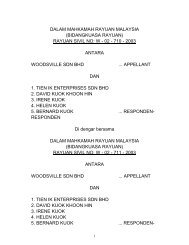rayuan jenayah no: q-05-146-2006 antara pendakwa raya
rayuan jenayah no: q-05-146-2006 antara pendakwa raya
rayuan jenayah no: q-05-146-2006 antara pendakwa raya
You also want an ePaper? Increase the reach of your titles
YUMPU automatically turns print PDFs into web optimized ePapers that Google loves.
DALAM MAHKAMAH RAYUAN MALAYSIA<br />
(BIDANGKUASA RAYUAN)<br />
RAYUAN JENAYAH NO: Q-<strong>05</strong>-<strong>146</strong>-<strong>2006</strong><br />
ANTARA<br />
PENDAKWA RAYA …PERAYU<br />
DAN<br />
ZAINAL ARPAN BIN MOLANA …RESPONDEN<br />
[Dalam perkara mengenai Perbicaraan Jenayah<br />
No. 45-02-2003-III dalam Mahkamah Tinggi Sabah<br />
dan Sarawak, di Kuching<br />
Antara<br />
Pendakwa Raya<br />
Dan<br />
Zainal bin Arpan Molana]<br />
CORAM: SURIYADI HALIM OMAR, JCA<br />
ABDUL WAHAB PATAIL, JCA<br />
LINTON ALBERT, JHC<br />
JUDGMENT OF THE COURT<br />
In this case the learned judge after applying the maximum<br />
evaluation test on the evidence adduced by the prosecution found<br />
that it had failed to make out a prima facie case against the<br />
respondent. He was thereupon acquitted and discharged without<br />
his defence being called. The appeal came before us and at the<br />
end of the hearing we dismissed the prosecution’s appeal.
The charge against the respondent reads as follows:<br />
2<br />
“That you, on 17.10.2002, at about 10.45 pm at Lot 3640, Taman<br />
Rasa Makmur, Petra Jaya, in the State of Sarawak, on your own<br />
behalf did traffic in a dangerous drug, to wit, 197.99 grammes of<br />
methamphetamine, and you thereby committed an offence under<br />
s. 39(B)(1)(a) Dangerous Drug Act 1952 and punishable under s.<br />
39B(2) of the same Act.”<br />
At the opening stage of her submission before us the learned DPP<br />
indicated that she was using a dual prong approach to establish<br />
the prosecution’s case. For the first approach, she would apply<br />
the presumptive provision to establish mens rea for the ingredient<br />
of possession, and thereafter alluding to s. 2 of the Dangerous<br />
Drugs Act 1952 (the Act) to establish the ingredient of trafficking<br />
i.e. by direct evidence. The alternative was that the respondent by<br />
direct evidence had physical possession of the drugs, and to<br />
establish the ingredient of trafficking, she would allude to s. 2 of<br />
the Act. On the latter ingredient of trafficking, this approach<br />
differed with the one at the High Court, where the DPP there had<br />
stated that reliance would be on direct evidence and “on<br />
presumption under the Dangerous Drugs” to establish the<br />
ingredient of trafficking (see F of the Appeal Record Vol.2).<br />
Scrutinising the opening address at the High Court, it was obvious<br />
that the learned DPP never mentioned that she would lead<br />
evidence to establish possession of the drugs by the respondent.<br />
The emphasis was more on information supplied by him leading to<br />
discovery of the impugned drugs in his house. The brief facts are<br />
as follows. On 17/10/2002 at about 10.30 p.m. the respondent
3<br />
together with his wife and mother-in-law were in front of the Hilton<br />
Hotel, Kuching, when they were stopped by the police. He was<br />
arrested as he was alleged to have acted in a suspicious manner<br />
when walking towards a car bearing registration number QSF 57.<br />
The police then instructed him to drive the car to the Sarawak<br />
Contingent Police Headquarters and upon arrival searched the car.<br />
The police found <strong>no</strong> drugs in it. Whether this was a mere flaw in<br />
the interpretation of human psychology by the police, when it<br />
mistook the “walking towards the car” as suspicious, exacerbated<br />
by the eventual embarrassment of <strong>no</strong> drugs being found in the car,<br />
or linked to some other mischievous reason, we have <strong>no</strong> idea.<br />
The respondent’s day got worse when the police then informed<br />
him that he would be detained under s. 3(1) of the Drug<br />
Dependants (Treatment and Rehabilitation) Act 1983 for a urine<br />
test. We felt some intimidation had come into play here as at that<br />
stage there was <strong>no</strong> legitimate reason for him to undergo this test.<br />
What started as a suspicious walk had culminated in a journey to<br />
the remand centre to await a urine test. The prosecution, through<br />
SP6, revealed that as the respondent did <strong>no</strong>t want to go for that<br />
urine test he thereupon told the police that he had drugs. His<br />
words were as follows: “saya ada menyimpan dadah di rumah<br />
(hereinafter to be referred as the Hilton statements).” After those<br />
words were uttered he was cautioned in accordance with s. 37A(1)<br />
of the Act.<br />
Following this lead, the respondent was alleged to have brought<br />
the police team to a house at Lot 3640, Taman Rasa Makmur,<br />
Petra Jaya. The respondent said he lived in that house. The<br />
police was led to his bedroom on the 3 rd floor, and inside the room
4<br />
the police recovered two syringes from the connected bathroom,<br />
and 4 plastic packets containing substance suspected to be<br />
dangerous drugs (hereinafter this location will be referred as the<br />
bedroom area). Drugs were retrieved from the right side pocket of<br />
a shirt which was in the cupboard inside the bedroom. The<br />
respondent was supposed to have handed over the drugs and the<br />
2 syringes to the police.<br />
Thereafter the respondent led the police to a store room located on<br />
the ground floor of the house and took out a black bag printed with<br />
the words “Felda Security” (P14). He opened the bag and handed<br />
to the police a blue cloth bag containing 2 plastic packets each<br />
containing crystalline substance suspected to be drugs, a weighing<br />
scale carrying the brand “Thinner”, a yellow cloth bag printed<br />
“Bally” containing one impulse sealer, a travel charger box<br />
containing a roll of plastic packets and two keys to apartment<br />
No.1108, Somerset Gateway, Kuching (this location will hereinafter<br />
referred to as the store room drugs).<br />
Upon analysis by the chemist (PW5), all the drugs seized were<br />
analysed as methamphetamine weighing 197.99 grams. Founded<br />
on this set of evidence the respondent was charged with the<br />
offence of drug trafficking. The prosecution called eight witnesses,<br />
including the arresting officer, the chemist, the investigating officer<br />
(PW6), and offered witnesses to the respondent. In the course of<br />
the hearing the prosecution, after a trial with a trial, failed to have<br />
certain remarks made by the respondent admissible e.g. the oral<br />
statements “Itulah bilik tidur saya”. The rejection of this statement<br />
as we saw it, did <strong>no</strong>t destabilise the prosecution’s case as there
5<br />
was some evidence to prove that the bedroom was indeed used by<br />
the respondent, his wife and children. PW7 i.e. the father-in-law<br />
was the supplier of that piece of evidence.<br />
In its submission, the prosecution at the High Court ventilated that<br />
the respondent had clear possession of the drugs, and had the<br />
requisite k<strong>no</strong>wledge of the nature of the drugs possessed.<br />
Further, the respondent did traffic the drugs. The combined<br />
quantity of the drug far exceeded the “trigger” weight under s.<br />
37(da) (xvi) of the Act and thus was presumed to be trafficking in<br />
the drug. This course of action and approach was in consonant<br />
with the approach to be undertaken supplied in the opening<br />
speech.<br />
The respondent on the other hand submitted that the prosecution<br />
had failed to prove a prima facie case based on the following<br />
factors:<br />
1. by perusing the opening statement, much rested on the<br />
admissibility and credibility of the alleged statement made by<br />
him, which fell under s. 27 of the Evidence Act 1950. That<br />
being so the Court should <strong>no</strong>t consider the evidence of what<br />
happened at the house if the Court was <strong>no</strong>t satisfied that the<br />
alleged information elicited in front of the Hilton Hotel was<br />
credible or reliable;<br />
2. the prosecution had suggested that if drugs were found in<br />
the bedroom, then the respondent must be guilty. According<br />
to the respondent this surely was <strong>no</strong>t the correct proposition<br />
of law as looking at the facts of this case, drugs found in the
6<br />
bedroom was an insignificant 2.23 grams. There were many<br />
possible inferences that went with it be it in relation to<br />
possession or purpose;<br />
3. the uncontroverted evidence in so far as the bedroom was<br />
concerned was that the respondent’s wife and children lived<br />
with him. The facts here could <strong>no</strong>t be taken in isolation, and<br />
taken cumulatively a reasonable doubt had been created at<br />
the prosecution’s stage as regards possession;<br />
4. there were <strong>no</strong> finger prints evidence on the plastic packets,<br />
which contained the substances, and there was <strong>no</strong> nexus<br />
between the drugs and the weighing machine, sealing<br />
machine or the travel charger box. There was <strong>no</strong> evidence<br />
of drugs sticking on the items either; and<br />
5. under s. 37(d), the prosecution still have to prove that the<br />
respondent was in actual custody or in control of dangerous<br />
drugs. The prosecution failed to prove that the respondent<br />
had exclusive use of the bedroom and store room. Without<br />
this legal prerequisite established the court could <strong>no</strong>t invoke<br />
s. 37(da) (xvi) of the Act. For the latter provision, in a<br />
nutshell, any person who is found in possession of 50 grams<br />
or more in weight of methamphetamine shall be presumed,<br />
until the contrary is proved, to be trafficking in the said drug.<br />
It was obvious from the <strong>no</strong>tes of proceedings that the learned<br />
judge had some trying moments with both the prosecution and the<br />
defence and had even conducted an unnecessary trial within a<br />
trial. She also had the occasion to hold that an alleged s.27<br />
statement made in the house was inadmissible. Regretfully for the<br />
prosecution, the Hilton statements which were alleged to have led
7<br />
to the discovery of the drugs were also held inadmissible on the<br />
grounds that the entries in the pocket diary were <strong>no</strong>t made<br />
contemporaneously and that the police team acted on prior<br />
information. It was our finding after thoroughly sifting the <strong>no</strong>tes of<br />
proceedings that the learned judge had applied the right legal<br />
principles when arriving at that conclusion. The reasons had<br />
<strong>no</strong>thing to do with the voluntariness of the statements as s. 27 is<br />
silent on this requirement unlike a confession or a cautioned<br />
statement (Francis Anthonysamy v Public Prosecutor [20<strong>05</strong>] 3 MLJ<br />
389; Chandrasekaran & Ors v Public Prosecutor [1971] 1 MLJ<br />
152).<br />
Perusing the grounds of judgment the learned judge had<br />
meticulously considered the opening address and their legal<br />
intricacies. She took great pains to state that it was mandatory<br />
and incumbent upon the prosecution before opening its case to<br />
state, inter alia, the proposed evidence to prove the guilt of the<br />
respondent and if the prosecution failed to mention an alleged<br />
admission, but only introduced it at the trial proper, then the<br />
evidence was an afterthought. We have <strong>no</strong> disagreement with this<br />
view either.<br />
Despite the want of mention of the ingredient of possession in the<br />
opening speech, the learned judge nevertheless proceeded to<br />
consider the strength and weakness of the respondent’s<br />
possession of the drugs. She eventually held that the prosecution<br />
failed to establish the ingredient of possession let alone the<br />
trafficking ingredient. Upon reading the grounds of judgment, it<br />
was obvious that the learned judged had applied the maximum
8<br />
evaluation test and thereupon concluded that the prosecution had<br />
failed to make out a prima facie case. There was <strong>no</strong>thing wrong in<br />
this test or eventual decision (Looi Kow Chai & A<strong>no</strong>r v Public<br />
Prosecutor [2003] 2 MLJ 65; PP v Mohd Radzi bin Abu Bakar<br />
[20<strong>05</strong>] 6 MLJ 393; Balachandran v PP [20<strong>05</strong>] 1 CLJ 85).<br />
The Court of Appeal’s additional factual finding<br />
Having perused the opening speech of the prosecution, it was<br />
obvious that the prosecution would rely heavily on the Hilton<br />
statements. Section 27 of the Evidence Act 1950 therefore would<br />
take the front seat for the prosecution. As it were the prosecution’s<br />
case was derailed when, proceeding on a finding of fact, the<br />
learned judge held those statements as being inadmissible.<br />
It must be understood that the format of her grounds of judgment<br />
were “broad grounds” hence the want of a detailed discussion of<br />
the s.27 statements in it but they sufficed. Her reasons were<br />
similar to “the grounds as summarised by the learned defence<br />
counsel...” Having read the defence written submissions and the<br />
connected evidence found in the <strong>no</strong>tes of proceedings, and<br />
simultaneously gauging the approach of the learned judge when<br />
arriving at that finding of fact, we failed to disagree with her.<br />
Moving on from there we realised that the decision of the learned<br />
judge to hold the statements made in front of the Hilton Hotel as<br />
inadmissible would have a profound overall effect on the case of<br />
the prosecution. Without that information, the case of the<br />
prosecution would take a serious twist, in that instead of the
9<br />
respondent leading the police to the discovery of the drugs the<br />
reverse holds true. The overall effect was that the recovery of the<br />
drugs even though successful, was instead carried out by the<br />
police in their <strong>no</strong>rmal course of investigation rather than discovered<br />
as a result of the respondent’s information.<br />
It was undeniable that the drugs founds came from two locations,<br />
namely the respondent’s bedroom, which had an attached<br />
bathroom, and the store room located on the ground floor of the<br />
house. The 2 sets of drugs were lumped together by the<br />
prosecution and the gross weight arrived at by the chemist was<br />
197.99 grams of methamphetamine. Needless to say the drugs<br />
retrieved from a shirt pocket in the bedroom, which weighed only<br />
2.23 grams, would <strong>no</strong>t have been sufficient to attract the<br />
presumptive provision of s. 37(da)(xvi) of the Act.<br />
Regardless of the finding of the learned judge regarding the issue<br />
of possession at page 861, we also undertook our own exercise<br />
pertaining to this ingredient. With there being a<strong>no</strong>ther person living<br />
in that bedroom i.e. the wife, could we safely say that the drugs<br />
were <strong>no</strong>t hers i.e. discounting any possession by the respondent?<br />
In Gooi Loo Seng v PP [1993] 2 MLJ 137 Edgar Joseph Jr. SCJ<br />
quashed the conviction on the grounds inter alia that the drugs<br />
could have been hidden by others, especially the girlfriend, who<br />
had access to the room and hidden the drugs there when the<br />
accused person was absent. We also had to bear in mind that 11<br />
people lived in that house, inclusive of his father-in-law, mother-in-<br />
law and the maid. When probed by us whether that shirt was<br />
owned by the father-in-law the learned DPP conceded that such a
10<br />
possibility was never eliminated at the High Court. When we<br />
pursued the matter and posed the follow up question of whether<br />
the shirt (P29) was actually a lady’s blouse, after having sight of<br />
the pictures, as it “looks like a female shirt”, again the learned DPP<br />
could <strong>no</strong>t confirm it either way. In a word that shirt could have<br />
been anybody’s. If it was the respondent’s drugs there was <strong>no</strong><br />
reason for him to hide them in a shirt possibly owned by some<br />
else, regardless of the sex, and thus risk the drugs being<br />
discovered. Putting it a<strong>no</strong>ther way, if the drugs were in someone<br />
else’s shirt then it was more likely that it was the owner of the shirt<br />
who hid the drugs in it, thus exonerating the respondent of having<br />
custody and control of them. Without these two ingredients being<br />
successfully established the issue of mens rea related to<br />
possession will <strong>no</strong>t be triggered: the stage of possession can only<br />
be considered after the custody and control hurdle have been<br />
cleared.<br />
Even if the learned judge had decided in favour of the prosecution<br />
regarding the Hilton statements, and even if the respondent had<br />
custody and control of the drugs found in the bedroom, we were<br />
<strong>no</strong>t convinced that the 2.23 grams of methamphetamine were for<br />
trafficking. There was every indication that the latter drugs were<br />
meant for self-consumption. The first indication was, if the 2.23<br />
grams drugs were meant for trafficking, why were they found at<br />
quite a distance from the larger amount found at the store room?<br />
Is insignificant size would clearly put it outside the reach of the<br />
presumption provision of trafficking.
11<br />
And then there were the syringes which were found in the<br />
bathroom. These 2 syringes were <strong>no</strong>t new and had been used at<br />
some point of time as the chemist found traces of ephedrine in<br />
them. In the course of the cross-examination SP6 admitted that<br />
those syringes were for drug taking (Q: Mengikut pengalaman<br />
kamu syringe itu untuk apa? J: Untuk mengambil dadah). It is<br />
undeniable that that there was some evidence supplied by the<br />
prosecution through SP6 (page 680 of the Appeal Record) to<br />
establish the respondent as a drug taker. On the above reasoning<br />
there was a high degree of probability that those syringes were<br />
part of his paraphernalia, and the 2.23 grams of methamphetamine<br />
were set aside to satisfy his drug cravings. To wind it up, if those<br />
drugs found in the bedroom were meant for possible self-<br />
consumption, to deliberately or even erroneously lump them with<br />
those found at the store room would seriously taint the trafficking<br />
charge. No amount of explanation by the prosecution could save<br />
the tainted charge.<br />
We <strong>no</strong>w discuss the drugs found at the store room. With the Hilton<br />
statements being held inadmissible, then the testimony adduced<br />
by the prosecution that the respondent led the police to the drugs<br />
at the store room on the ground floor of that 3 storey house, must<br />
be rejected. Nothing incriminating found there could be attributed<br />
to the respondent. It would be the police who led him to the store<br />
room and there recovered a black bag (P14) from a small<br />
compartment in which were retrieved drugs subsequently<br />
confirmed to be methamphetamine. There the police seized some<br />
other items too. Unless there was some evidence that could<br />
inculpate the respondent which led to the discovery of the drugs
12<br />
such discovery therefore could be premised on any reason<br />
imaginable. Without that incriminating evidence the drugs were<br />
merely recovered from the store room in a <strong>no</strong>rmal investigation<br />
rather than discovered pursuant to the respondent’s contribution.<br />
In order to establish the ingredient of possession of the drugs<br />
found at the store room (and the bedroom on the third floor), and<br />
hence having the requisite mens rea, be it by direct evidence or<br />
the invocation of the presumption provision, the prosecution must<br />
first of all cross the hurdle of having established custody and<br />
control of them. From the set of facts, <strong>no</strong>t only did the prosecution<br />
fail to establish that the respondent had custody and control of the<br />
drugs in his bedroom but also the drugs in the store room. For<br />
starters, the house was owned by his father-in-law and prima facie<br />
was the master of the house, together with its contents e.g. P14<br />
from which drugs were recovered. Evidentially P14, a bag that<br />
held the words “FELDA Security”, seized by the police in the store<br />
room and from which were retrieved the main bulk of the drugs and<br />
other items e.g. the “Thinner” weighing scale, a yellow cloth bag<br />
carrying the brand “Bally”, an impulse sealer and the like, was<br />
admitted by PW7 to be his (see Record of Appeal page 764). With<br />
P14 being his, why the latter was <strong>no</strong>t individually charged or jointly<br />
charged with the respondent was a mystery to us. He (PW7) also<br />
in clear terms testified that the house was occupied by <strong>no</strong> less than<br />
11 persons amongst them his maid, he and his wife, his daughter,<br />
the respondent and wife, and the respondent’s children. The<br />
spectre of all these people, especially the maid running loose in<br />
the house as she would have access to every part of the house,<br />
which would include the store room when doing her chores, would
13<br />
add to the whittling away of the respondent’s custody and control<br />
of the drugs. In Pang Chee Meng v Public Prosecutor [1992] 1<br />
MLJ 137 Abdul Hamid Omar LP quashed the conviction of the<br />
accused person as the prosecution had failed to prove that the<br />
accused had exclusive custody and control of the drugs found in<br />
the room where there were at least three others with access to the<br />
room. In the current appeal with 11 people having access to the<br />
store room and the s. 27 statement by the respondent having been<br />
decided to be inadmissible the ingredients of custody and control<br />
thus were still at large (see also Gooi Loo Seng v Public<br />
Prosecutor [1993] 2 MLJ 137). In Choo Yoke Choy v Public<br />
Prosecutor [1992] 2 MLJ 632 Anuar J (as he then was) when<br />
delivering the decision of the Supreme Court per curiam said:<br />
“Without the evidence of custody or control, the<br />
presumption of possession under s. 37 (d) of the<br />
Act can<strong>no</strong>t arise.”<br />
With the failure by the prosecution to establish custody and control<br />
of the drugs, <strong>no</strong>t only will the prosecution fail to establish<br />
possession by direct evidence but also by the invocation of the<br />
presumption provision.<br />
In order to establish the ingredient of trafficking of the 197.99<br />
grams of methamphetamine (which included the ‘tainted’ amount<br />
of 2.23 grams meant for personal consumption), the prosecution<br />
before us alluded to the provision of s. 2 of the Act. For the sake<br />
of argument, if indeed the prosecution had established the<br />
ingredient of custody and control and possession, the proving of
14<br />
the ingredient of trafficking is a totally different matter. The learned<br />
DPP in her written submission picked out keeping, concealing and<br />
storing in order to bring the respondent squarely within s. 2 of the<br />
Act. The definition of trafficking reads thus:<br />
“trafficking” includes the doing of any of the following acts,<br />
that is to say, manufacturing, importing, exporting,<br />
keeping, concealing, buying, selling, giving, receiving,<br />
storing, administering, transporting, carrying, sending,<br />
delivering, procuring, supplying or distributing any<br />
dangerous drug otherwise than under the authority of this<br />
Act or the regulations, made under the Act; ”<br />
Without the need of repeating any previous discourse of this<br />
section, what needs to be repeated are the established<br />
enunciations by recent authorities, which demand something more<br />
than passive possession before the ingredient of trafficking is said<br />
to have been established. In Ong Ah Chuan v Public Prosecutor<br />
[1981] 1 MLJ 64 Lord Diplock when defining ‘traffic’ said:<br />
“To traffic” in a controlled drug so as to constitute<br />
the offence of trafficking under section 3 involves<br />
something more that passive possession or self-<br />
administration of the drug; it involves doing or<br />
offering to do an overt act of one or other of the<br />
kinds specified in paragraph (a) of the definition of<br />
“traffic” and “trafficking” in section 2. Even apart<br />
from any statutory definition, the ordinary meaning<br />
of the verb “to traffic”, in the particular context of
trafficking in goods of any kind, imports the<br />
existence, either in fact or in contemplation, of at<br />
least two parties: a supplier and a person to whom<br />
the goods are to be supplied. This concept,<br />
involving transfer of possession, is reflected in the<br />
statutory definition itself....<br />
“This is a very wide description of acts that may be<br />
treated as equivalent to the substantive offence of<br />
trafficking; nevertheless, in their Lordships’ view, it<br />
is clear from the structure of the Drugs Act and the<br />
distinction drawn between the offence of having a<br />
controlled drug in one’s possession and the offence<br />
of trafficking in it, that mere possession of itself is<br />
<strong>no</strong>t to be treated as an act preparatory to or in<br />
furtherance of or for the purpose of trafficking so as<br />
to permit the conviction of the possessor of the<br />
substantive offence. To bring the provisions of<br />
sections 10 and 3(c) into operation some further<br />
step or overt act by the accused is needed, directed<br />
to transferring possession of the drug to some other<br />
15<br />
person...(emphasis supplied)”<br />
Augustine Paul J in PP v Mohd Farid bin Mohd Sukis & A<strong>no</strong>r<br />
[2002] 3 MLJ 401 referring to the above case endorsed the<br />
existence, either in fact or in contemplation, of at least two parties:<br />
a supplier and a person to whom the goods are to be supplied. PP<br />
v Abdul Manaf bin Muhammad Hassan [<strong>2006</strong>] 3 MLJ 193 too had<br />
referred and agreed with the above case of Ong Ah Chuan v PP.
16<br />
Distilling the above cases, to constitute the ingredient of trafficking<br />
would involve the doing or offering to do an overt act by the<br />
trafficker and would involve at least two parties. That activity<br />
would also involve the transfer of possession from a supplier and a<br />
person to whom the goods are to be supplied. No evidence of the<br />
existence either, in fact or in contemplation of two parties, of the<br />
distribution of the drugs have been adduced. At best there was<br />
only mere possession of them (of which ingredient was also <strong>no</strong>t<br />
established).<br />
The prosecution made much of the conduct (s.8 of the Evidence<br />
Act 1950) of the respondent to establish that overt act. He was<br />
said to have cried, hugged and begged PW6 at the store room.<br />
These alleged acts happened when he was with the police but yet<br />
<strong>no</strong> family members who were present were called to confirm these<br />
dramatic acts. In fact these events were never recorded in the<br />
police pocket book although PW6 admitted that important matters<br />
would be recorded.<br />
Chro<strong>no</strong>logically in this case the respondent neither attempted to<br />
escape when stopped in front of the hotel or when drugs were<br />
found in his bedroom, and only broke down after drugs were found<br />
outside his room. For the sake of analogy, in a drug trafficking<br />
case, where an accused person attempts to flee upon seeing the<br />
police, such conduct becomes irrelevant if his action was the result<br />
of other causes (Parlan Dadeh v PP [2009] 1 CLJ 717). In this<br />
case his dramatic behaviour therefore could be construed either<br />
way as he could also have been concerned for his family after the
17<br />
drugs were recovered in the store room or perhaps realised that<br />
something amiss had taken place for <strong>no</strong> fault of his (Abdullah<br />
Zawawi bin Yusof v Public Prosecutor [1993] 3 MLJ 1).<br />
To wind up on this trafficking ingredient, drugs were <strong>no</strong>where<br />
found near him when initially stopped by the police. At the<br />
locations where the police recovered the drugs <strong>no</strong> second party<br />
was seen hanging around or for that matter any transfer of<br />
possession of the drugs was in the offing or had taken place. In<br />
fact there was <strong>no</strong> worthy tell-tale or overt act, conduct or evidence<br />
to upgrade mere possession to trafficking (PP v Haling Arala<br />
Jimjani [2008] 4 CLJ 163). At best there was only passive<br />
possession of the drugs (an ingredient which the prosecution also<br />
failed to establish). On that premise we were satisfied that the<br />
prosecution had also failed to establish the ingredient of trafficking.<br />
With the failure of the prosecution to establish custody, control and<br />
possession of the drugs, together with the ingredient of trafficking,<br />
let alone the charge being defective as it included the drugs meant<br />
for self-consumption, we had <strong>no</strong> hesitation in dismissing the<br />
appeal. The High Court order was thereupon affirmed.<br />
Dated this 2 nd March 2011<br />
SURIYADI HALIM OMAR<br />
Judge<br />
Court of Appeal, Malaysia
Counsel For The Appellant : Noorin Badaruddin<br />
Solicitors For The Appellant : Jabatan Peguam Negara<br />
Counsel For The Respondent : Francis Wee<br />
Solicitors For The Respondent : Messrs Wee & Partners<br />
18


